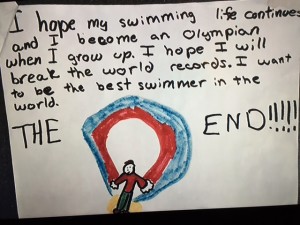By: Martin Grunburg
I love the Olympics. To witness the best athletes in the world competing on the biggest stage — it’s packed with entertainment and, better still, fantastic lessons about achievement.
But, where do you think it really begins for an Olympian?

It would be hard to argue that it doesn’t begin with a vision — A DREAM!
Yep, that’s Ryan Murphy’s illustration at eight years old. (Murphy won gold medals in both the 100M & 200M Backstroke.) He drew this image as part of a “story” he wrote to his parents.
Take a closer look, though: It’s clear that even as a young boy, Ryan had a vision. He wrote, “I hope my swimming life continues and I become an Olympian when I grow up. I hope I will break the world records. I want to be the best swimmer in the world”
You may be saying, “Sure, but everyone has dreams…what makes his or any Olympian’s dreams come true?”
While I’m certain there are a host of influences, I think the starting point is undeniably a clear vision, a dream.
And, on that note, it’s probably worthwhile to revisit the old adage about dreams and goal-setting. “A dream is just a goal with a deadline.”
The fact is, Olympians have more than just a dream. Each Olympic dream comes with its very own hard-set, deadline!
Your Goal Achievement, Action Items
(Homework and Checklist):
For fun, let’s dissect Ryan’s example and extract a few basic rules of goal achievement for ourselves.
1) Vision: Identify, project and create a crystal-clear vision. Can you imagine and see the ideal outcome?
2) Deadline: Make the vision even more concrete by adding a deadline, even if you suspect the deadline may change. Establishing a deadline makes the vision/dream more tangible.
3) Write it up! Draw it, illustrate and/or color it. Many people even create vision boards!
Example#1: Watch John Assaraf’s remarkable story about his vision board and mansion (video).
Example #2: Why Simon Whitfield Believes ‘Anything Is Possible‘. Simon journaled daily and affirmed his vision of Olympic greatness. “I have a journal where every single day I wrote ‘I am the Olympic champion’ before it ever happened.”
Example #3: Eddie the Eagle. An unbelievable story turned Hollywood movie. Throughout the movie, Eddie consistently tells his family that he will be an Olympian. (Movie Link Amazon). Is the movie a bit corny? Yes! Watch it anyway. You’ll see the kind of vision, determination, and resilience (frankly) — all the principles that are outlined here — in action!
5) Believe it! As the late, great Norman Vincent Peale (author of The Power of Positive Thinking) used to say, “Conceive, believe and achieve!”
6) Get Emotional over it! The clear vision, the deadline, and the belief ought to create intense emotions. Emotions like excitement or even fear are common. If you don’t feel intense emotions around your goal (with a deadline!), something is wrong and it may be that you don’t …
7) Know your “Why?”! What’s the reason behind your dream-goal. The Why is essential because there are going to be innumerable setbacks along the journey, and if you don’t know the WHY and have those related emotions to lean into when the going gets tough, you will likely quit!
8) Resilience: Adapt and overcome. Can’t emphasize this one enough. If you watch the movie “Eddie the Eagle” you notice that he continues to adapt his strategies and tactics. Originally intent on being a summer Olympic athlete, he shifts to the winter games, and then ultimately realizes he must shift even the sport in which he decides to compete. A brilliant example of adaptation!
9) Finally, DO it! Or, as Nike says, “Just do it.” Of course, The Habit Factor’s corollary to this is “Just do it— often.” One must create the habits — the right behaviors (consistently) — and that is the difference maker. There isn’t an Olympic champion (past, present or future) who hasn’t formed the habits to make their dream a reality.
So, how does your check-list look? Does it look like Eddie the Eagle’s?
Again, this isn’t really about the Olympics or Olympians, it’s about YOU.
They did it— you can to!
Keep the dream alive.
~mg